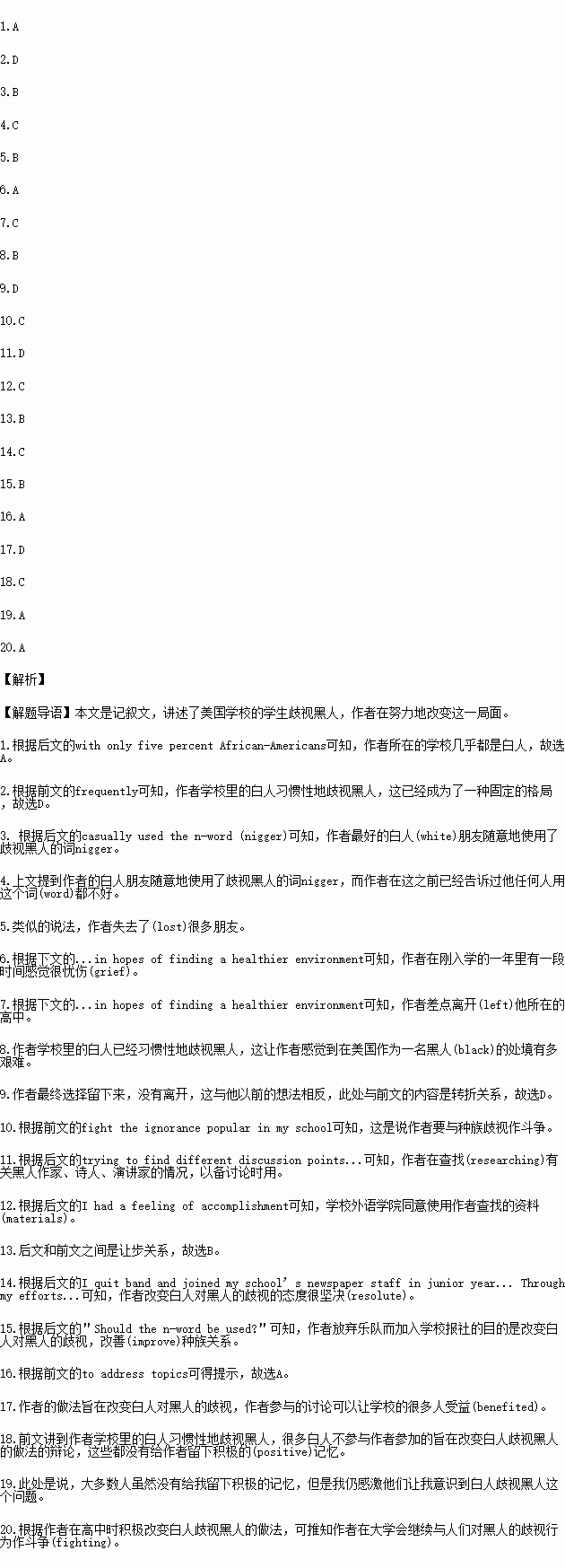题目内容
阅读下面短文,从短文后各题所给的A、B、C和D四个选项中,选出可以填入空白处的最佳选项。
I owe a great deal to my racist friends: they have given me a reason to try and achieve something great in my life.
My school is almost 1 with white students with only five percent African-Americans. During Marching Band freshmen year, I started to notice how frequently my white friends 2 the black people they saw. Once my best 3 friend casually used the n-word (nigger) after I had described to him the isolation I felt when the __4__ was used by anyone of any race. I have 5 numerous friends due to similar statements.
The 6 overtook me for a period of the freshmen year. I nearly 7 my high school in hopes of finding a healthier environment. Finally, I had learned what it meant to be 8 in America.
Instead of leaving, 9 , I chose to stay and fight the ignorance popular in my school. My first __10__ would be Black History Month. In sophomore year I was asked to create an activity for Black History Month. I spent hours 11 black authors, poets and speakers, trying to find different discussion points that could be made in the classrooms in my school. When told that the English Department at my school agreed to use my 12 , I had a feeling of accomplishment 13 many of my classmates doubted my ability.
However, I remained 14 . I quit band and joined my school’s newspaper staff in junior year, to address topics to help 15 race relations. Through my efforts, a meeting was held for students to discuss 16 such as "Should the n-word be used?" Though many white people didn’t attend it, the conversations I participated in __17__ many others at the school.
Though the majority of the people at my school have not left me 18 memories, I am grateful for the awareness they have helped 19 in me. As I move on to college I am ready to go on 20 ignorance and injustices.
1.A. filled B. acquainted C. impressed D. interfered
2.A. encouraged B. greeted C. influenced D. stereotyped
3.A. considerate B. white C. enthusiastic D. intelligent
4.A. standard B. method C. word D. opportunity
5.A. made B. lost C. changed D. supported
6.A. grief B. task C. challenge D. adoption
7.A. compared B. remind ed C. left D. entered
8.A. popular B. black C. stupid D. cautious
9.A. therefore B. also C. besides D. however
10.A. choice B. attempt C. battle D. visit
11.A. meeting B. admiring C. becoming D. researching
12.A. honors B. resources C. materials D. powers
13.A. so B. though C. unless D. because
14.A. successful B. calm C. resolute D. painful
15.A. ignore B. improve C. battle D. check
16.A. topics B. impacts C. situations D. missions
17.A. harmed B. gathered C. disgusted D. benefited
18.A. deep B. special C. positive D. negative
19.A. bring out B. take in C. hold up D. keep off
20.A. fighting B. ignoring C. proving D. witnessing
 学期复习一本通学习总动员期末加暑假延边人民出版社系列答案
学期复习一本通学习总动员期末加暑假延边人民出版社系列答案 芒果教辅暑假天地重庆出版社系列答案
芒果教辅暑假天地重庆出版社系列答案
